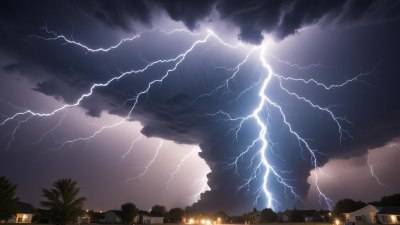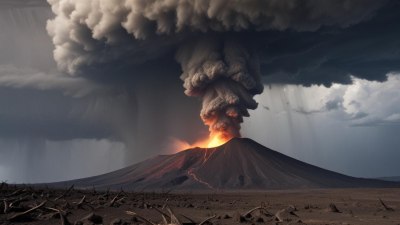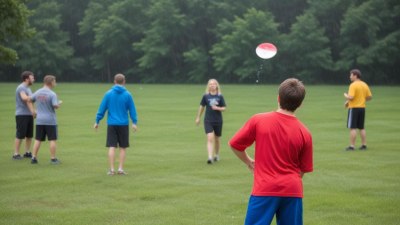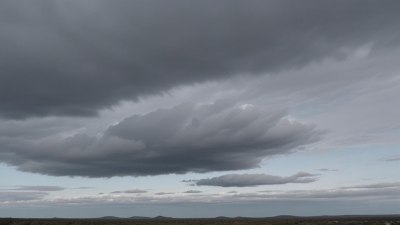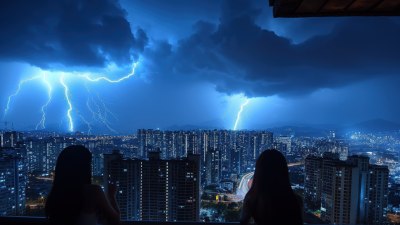Social Events in Winter Are Basically Low-Pressure Systems
Explore how social events in winter act like low-pressure systems, influencing moods, interactions, and community dynamics in unique ways.
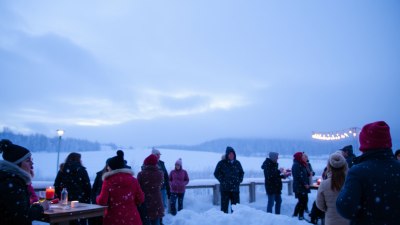
Winter social events often carry a distinct atmosphere, much like meteorological low-pressure systems that stir the air and change weather patterns. These gatherings, whether they be holiday parties, community festivals, or friendly get-togethers, seem imbued with emotional and social currents that influence people's moods and interactions in subtle but profound ways.
To understand this compelling metaphor, it helps to examine what low-pressure systems are and how they shape the environment. In meteorology, a low-pressure system forms when warm air rises, causing cooler air to rush in and fill the void. This dynamic often leads to cloud formation, precipitation, and windy conditions. Analogously, winter social events create an emotional 'vacuum' by drawing people out of the solitude and stillness that often characterize the cold months and inviting them into shared spaces of warmth, conversation, and connection.
Winter as a season offers a unique backdrop for social events. The shortened daylight hours and colder temperatures naturally reduce outdoor activities, funneling much of social engagement indoors. Homes, community halls, and cafes become focal points where people gather to break the isolation the season can impose. This concentrated social energy resembles the convergence of air masses around a low-pressure center, where disparate elements combine to generate new dynamics.
One key feature of winter social gatherings is their ability to shift emotions in a manner reminiscent of atmospheric changes. Just as low-pressure systems can produce storms or calm weather depending on various factors, social events can uplift spirits or, occasionally, stir tension, depending on the participants' moods and interactions. Holiday seasons like Christmas, Hanukkah, or New Year’s inherently carry strong cultural expectations, which add layers of complexity to these gatherings.
The collective emotional charge during these winter events often results in heightened empathy and bonding. People tend to share stories, exchange gifts, and participate in rituals that reaffirm social ties. These activities release endorphins and oxytocin, fostering feelings of happiness and trust. This phenomenon mirrors the way low-pressure systems can bring about the release of latent heat through condensation, energizing the atmosphere and propelling weather changes.
Moreover, winter social events function as crucial counterbalances to the isolation that the season might impose. The cold and the early sunsets can exacerbate feelings of loneliness and seasonal affective disorder (SAD) for some individuals. In this context, social gatherings act as therapeutic encounters that provide warmth—both literally, from shared spaces—and emotionally, from the human connections they facilitate.
It is also notable how the design and ambiance of winter events contribute to this metaphorical low-pressure system effect. Decorations such as twinkling lights, candles, and warm colors create an inviting atmosphere that draws people in. The sensory elements mimic the atmospheric energy and instability of low-pressure zones, sparking excitement and anticipation among attendees.
The dynamic nature of winter social events also extends to their unpredictability. Just as a low-pressure system’s path and intensity can be difficult to forecast with precision, social outcomes at these gatherings can vary widely. Factors such as the mix of personalities, recent experiences of attendees, and the event’s structure influence whether the gathering culminates in joyous celebrations or awkward discomfort.
Importantly, winter social events can serve as microcosms for community resilience. As low-pressure systems remind us of nature’s cycles of disruption and renewal, these gatherings often mark moments where communities come together to reinforce bonds, share resources, and prepare for the challenges of the season ahead. The collective energy generated in these events can foster a sense of mutual support that lasts well beyond the immediate occasion.
Another interesting aspect of the comparison lies in the way winter events encourage adaptability and improvisation. People often have to navigate challenges such as travel difficulties caused by winter weather, last-minute changes in plans, or managing the emotional complexities heightened by the season. This necessity to adjust and accommodate reflects the flexible, evolving nature of low-pressure systems as they interact with surrounding weather patterns.
Social scientists have noted that the psychological impacts of winter gatherings are significant. Research shows that social engagement during these months can mitigate symptoms of depression and anxiety related to seasonal changes. The symbolic and structural roles of ritualistic events—like holiday dinners or seasonal performances—allow individuals to anchor their personal experiences within shared narratives, helping them negotiate the emotional 'storms' of the season.
From an anthropological perspective, winter social rituals often incorporate themes of light, rebirth, and hope, which align with the natural cycles of the earth as it approaches the return of longer days. These themes resonate on a deeply human level, contributing to the emotional potency of the gatherings. Much like a low-pressure system initiates change and renewal in the atmosphere, these events symbolize the promise of transformation and continuity within the community.
It is also interesting to consider how winter social events blend the tension between intimacy and expansiveness. On one hand, the cold weather and indoor spaces create intimate settings where personal connections deepen. On the other hand, the gatherings often bring together diverse groups, creating expansive networks and social webs. This duality mirrors the complex meteorology of low-pressure systems, which can span vast areas yet create intensely localized effects.
Furthermore, the sensory experience of winter social events amplifies their metaphorical connection with low-pressure systems. The tactile warmth from fireplaces, the scent of pine and spices, the taste of special seasonal foods, and the sounds of music and laughter all combine to create a rich, multisensory environment. This richness adds depth to the social atmosphere, much as moisture-laden air and temperature gradients add complexity to an atmospheric system.
Children’s participation in winter social events is also crucial to sustaining the community’s emotional weather cycles. Their excitement and innocence often serve as catalysts for joy and renewal, energizing older generations and reminding all participants of the cyclical nature of life. These interactions can be related to how low-pressure systems often trigger growth in flora and fauna following their passage through increased precipitation and sunlight.
Interestingly, technological innovations have influenced the way winter social events operate, enhancing their reach but sometimes diminishing their immediacy. Virtual gatherings have become more common, particularly in recent years, enabling participation across distances but lacking the tactile intimacy and sensory richness of in-person events. This shift parallels how meteorological sensing technologies have enhanced understanding of low-pressure systems but still cannot replace the experiential aspect of weather phenomena.
In examining winter social events as analogous to low-pressure systems, one can also appreciate the role of cultural diversity and variation. Regions with different climates and traditions celebrate winter in distinct ways, leading to a variety of social dynamics and emotional landscapes. For example, Scandinavian countries emphasize communal sauna sessions and cozy 'hygge,' while other areas may highlight outdoor ice skating or winter markets. These differences reflect the range of possible expressions within the broader metaphor and underscore the adaptability of social systems to environmental conditions.
Another layer worth exploring is the relationship between winter social events and economic activity. The surge in gatherings often coincides with increased consumption in sectors like hospitality, retail, and entertainment. This economic pulse can be seen as a side effect of the social energy generated by the events, similar to how low-pressure systems can influence multiple environmental factors beyond direct weather conditions.
From a poetic standpoint, the comparison between social gatherings and low-pressure systems evokes the image of invisible forces shaping human experience. Just as the atmosphere invisibly swirls to produce weather, unseen interpersonal dynamics and shared emotions build momentum to animate and transform social spaces during winter. This perspective offers a rich framework for appreciating the depth and complexity of seemingly simple holiday parties or casual meetups.
Psychologically, the idea of low-pressure social systems helps explain why people often feel both energized and vulnerable during winter events. The raising of social 'pressure' through interaction releases stored emotional energy, sometimes leading to expressive moments or conflict resolution. It also can open pathways to personal growth as individuals confront seasonal moods and relational patterns within the communal setting.
The interplay of light and dark during winter events intensifies this emotional dynamic. Many celebrations intentionally incorporate illumination, from candlelight vigils to sparkling decorations, symbolizing hope and light in the midst of darkness. This dynamic echoes low-pressure systems that bring clouds and precipitation but also set the stage for clearer skies and sunlight in their aftermath.
In practical terms, planning and hosting winter social events means managing these emotional and logistical pressures. Organizers must consider timing, space, ambience, and inclusivity to create welcoming environments. Understanding the metaphor of low-pressure systems can help anticipate the potential for emotional fluctuations and guide efforts to foster positive outcomes.
Community leaders and social planners might also apply this metaphor to promote resilience during winter months. By encouraging consistent social opportunities and rituals, they effectively maintain steady low-pressure 'centers' that keep social energy flowing and prevent stagnation or isolation. This proactive approach aligns with meteorological strategies that study and respond to atmospheric patterns to mitigate adverse weather effects.
Another practical implication involves recognizing the importance of rest and recovery after these social 'storms.' Just as the atmosphere needs time to stabilize following a low-pressure system’s passage, individuals and communities benefit from periods of quiet and reflection after intense social activity. Balancing engagement with downtime supports emotional health throughout the winter season.
Furthermore, examining winter social events through the lens of low-pressure systems encourages appreciation for the unpredictable and emergent qualities of human interaction. These gatherings are not fixed or uniform but evolve dynamically, shaped by numerous subtle forces—personal histories, cultural contexts, environmental conditions—all contributing to their unique character and impact.
Extending the metaphor, holiday traditions can be seen as the atmospheric 'fronts' where different social currents meet—family expectations, cultural norms, personal desires—which occasionally create turbulence but also offer opportunities for new patterns to form. Navigating these intersections requires social skill and emotional intelligence akin to weather forecasting.
Finally, just as meteorologists monitor low-pressure systems to provide warnings and guidance, individuals and communities might benefit from mindful observation of their social environments during winter. Awareness of emotional shifts, group dynamics, and individual well-being helps steer events toward positive experiences and minimize potential disruptions.
Ultimately, understanding winter social events as low-pressure systems provides a powerful metaphor that enriches our appreciation of the season’s social fabric. It reveals the complex emotional and communal processes underlying seemingly ordinary gatherings and highlights the transformative potential embedded in shared human experiences amidst the cold and dark.
As winter unfolds each year, the recurrence of these social currents reminds us that just like the natural world, human communities continually adapt, renew, and grow through cycles of gathering and dispersal. Embracing this perspective invites a deeper connection to the rhythms of the season and the invisible forces shaping our interactions and wellbeing.
